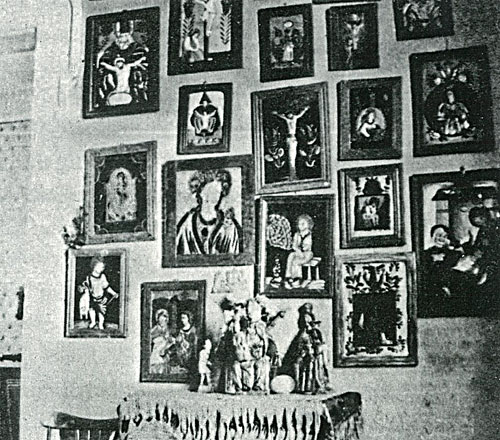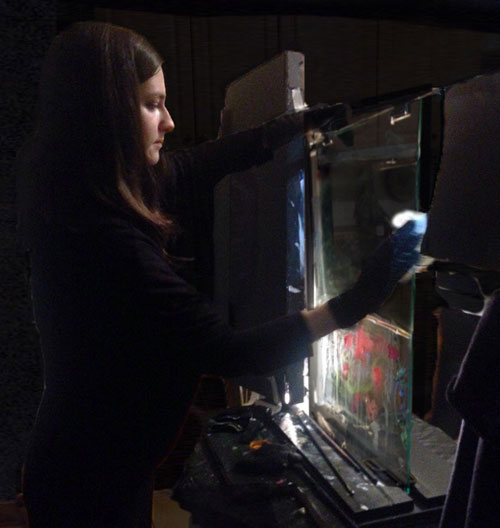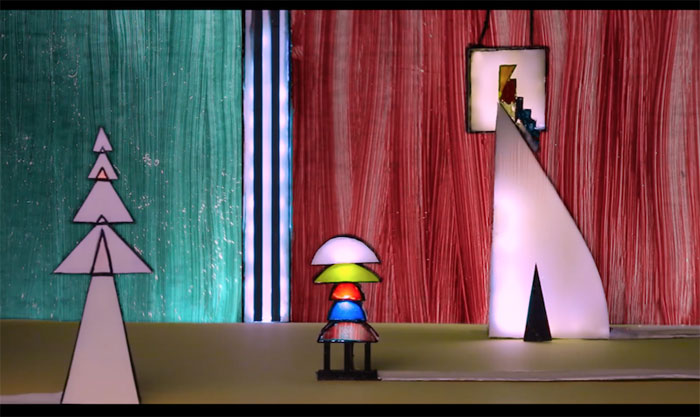|
Introduction
Welcome
back to
guest
writer
Giovanni
Vinciguerra,
who has
been taking
us through
Kandinsky's
staging of Pictures at an Exhibition,
adding to
our
understanding
of it an
unusual
degree of
historical
insight and
personal
engagement.
You can
read his
Part 1 and
Part 2 here.
This time,
Vinciguerra
takes us
along on
his train
of thought
that
travels
from
Kandinsky's
charming
paintings
on glass to
his own
Kandinsky-inspired
performances—an
ingenious
melding of
Kandinsky's
painting
and his
theatre
with
Vinciguerra's
own
thinking on
aesthetics
and his
practical
theatre
experience.
What an
important
pleasure it
is that
someone
this
knowledgeable
about
Kandinsky
is creating
performances
in his
name. For
anyone
captivated
by
Kandinsky's
theatre and
working
towards its
being a
standard
part of
theatre
studies,
the
plethora of
productions
using his
name simply
as an
advertising
or
grant-getting
ploy are a
scourge. We
can find
art
theatres,
art
schools,
museums and
more
advertising
"Kandinsky"
pieces by
people with
no apparent
interest or
expertise
in
Kandinsky's
own work or
ideas. As
I've
said
elsewhere,
such pieces
have dogged
recognition
of his
theatre
since his
death in
1944.
Enter
this
month's
writer, who
shares with
us his
unimpeachably
authentic
grasp of
Kandinsky
and his own
wonderfully
informed
artistic
initiative.
Lissa Tyler Renaud
*
To
begin this
Part 3, I
would like
to point
out what
fascinates
me above
all, as an
artist and
theatre
practitioner,
in the
genesis of
Kandinsky's
stage
production, Pictures at an Exhibition.
In my eyes,
this
production
was a
successful
theatre
phenomenon,
made
possible
thanks to
the
fortunate
confluence
of two main
factors:
1) A vision of the theatre as an occasion for a festive gathering
(I
mentioned
in my
previous
article the
place that
theatre
held at the
Bauhaus);
2) An
existing
complex and
rich
ecosystem
of arts and
crafts
connected
to other
humanities
fields (as
we know,
Kandinsky
himself was
not only a
painter,
but also an
art
theoretician,
professor
and poet).
These two
factors are
important
guidelines
for the
theatre
that I
aspire to,
a theatre
as
laboratory
of the
humanities.
With this
in mind, I
conducted
my studies
of
Kandinsky's
theatre,
alternating
practical
and
theoretical
research.
The sight of the "living pictures" in Kandinsky's Pictures at an Exhibition,
the set
pieces of
which move
and
assemble
themselves
in the
different
compositions,
is indeed
unique and
very
enigmatic.
One of the
most
touching
scenes is
the Ballet of Unhatched Chicks.
Striking in
the
simplicity
of its
execution,
the scene
consists of
a standing
canvas of 2
x 2 metres
(around 80
inches),
with
wave-like
slits.
Through
these wavy
slits three
torches
[flashlights]
shine, held
by someone
from behind
who is
moving
along them.
In the
dark, the
spectator
sees three
luminous
points that
follow the
jumping,
childlike
tone of the
musical
notes. This
scene is
described
in a review
by an
eyewitness
in 1928 as
"the
most deeply
affecting."
Horst Birr,
remembering
the
reconstruction,
said that
this scene
was one of
the most
expressive
in the
entire
production,
and always
evoked an
emotionally
powerful
response
from the
audience.
So how did
Kandinsky
come to
such a
result? One
of the
answers
occurred to
me as I
delved into
the
artist's
interest in
painting on
glass. He
was
introduced
to this
technique
in 1907 in
Murnau, an
upper
Bavarian
town, where
he spent
his summers
before
World War
I. Hinterglasmalerei [reverse
glass
painting]
was
developed
at the end
of the 18th
and during
the 19th
centuries
in the folk
and
religious
traditions
of
today's
Austria,
Bavaria and
Switzerland.
Murnau was
no
exception
and had
several
glass
painting
studios.
This
technique
consists of
applying
paint most
often to
the back
surface of
a piece of
glass, then
placing
coloured
cardboard,
foil or
bronze
paper as a
background
behind it
and
inserting
the work
into a
frame
(often also
painted).
As a
result,
what is
visible is
the mirror
image of
the
painting.
From 1908
onwards,
for several
years,
painting on
glass
became
Kandinsky's
main field
of
experimentation,
also
collecting
traditional
glass
paintings
of the
region.

Wall over Kandinsky's desk in Munich, covered with framed glass paintings from his
collection. Photo: Foundation Gabriele Münter and Johannes Eichner.
Wanting to experience this particular way of painting, I started doing it
together with my fellow students in the Stage Design Department of the
Moscow Art Theatre School in the autumn of 2016. We came to the idea of
using the technique in an almost performative form that observers could
attend. A similar idea can be found in the documentary The Mystery of
Picasso, made in 1955 by French filmmaker Henri-Georges Clouzot. We
installed a pane of glass vertically in an unlit room. The artists were
dressed completely in black, including black gloves. In the dark, only the
glass and the brush of the painter were lit from the back side of the glass.
One by one we painted while listening to the selected melody. On the other
side of the glass sat the observer. We filmed the process and edited it into
short films.
Link to Music on Glass:
https://www.behance.net/gallery/130368059/Music-On-Glass
Although these cut versions of the video do not fully allow us to enter into
the atmosphere, parallels with Kandinsky's performance can be found. The
glowing brushes resemble, for instance, the torches of the Ballet of
Unhatched Chicks, as well as the performative creation of the painting in
front of observers. As a spectator, I remember being completely absorbed
in the succession of brushstrokes in front of my eyes, and penetrating
through this medium the inexpressible thoughts of the invisible painter,
who was in darkness. On some level I became his accomplice, and from the
passive position of an observer I became a painter almost in place of the
obscured brush-holder. Kandinsky describes such an effect created by the
painting in his article Content and Form: "The inner element, taken alone,
is the emotion of the artist's soul, which (like the material musical tone of
one instrument, which causes the corresponding musical tone of another to
co-vibrate) evokes the corresponding vibration of the other person's soul,
the perceiver." With the other participants of Music on Glass we thought
about creating a veritable immersive performance for the public by
building a space defined by large glass or plexiglass walls that we would
have painted following a musical score. The project remains unrealised.

Sonya Lobacheva painting on glass in the performance Music on Glass (2016).
Photo: Giovanni Vinciguerra
For Kandinsky, Hinterglasmalerei was a medium that satisfied his artistic
needs in his gradual evolution towards abstract art. In fact, in the years
1904-1907 his canvases were progressively freed from the domination of
drawing. In 1907 he painted Colourful Life, where every brushstroke
becomes a special "sign," a separate and independent entity, but where
together they combine into a grand, polyphonic composition. For the
expression of these colour signs the properties of glass offered Kandinsky a
variety of pictorial possibilities. In the glass painting Golden Cloud (1918),
for example, the lines are painted on the front side of the glass, while the
paint is applied to the back side, which creates additional depth that
slightly changes when you change the angle from which you look at the
painting. Not constrained by the black lines, the colour extends beyond the
outlines, creating a kind of luminescence (see the golden cloud in the
upper right-hand corner of the painting). The shapes acquire a glowing
effect and are no longer only filled in but are also enveloped by the colour,
which lets the figures soar and gives them a sense of floating. These
characteristics are common for Kandinsky's Hinterglasmalerei. In the
1910s he started to work systematically with abstract forms.

Model of "The Old Castle" in Pictures at an Exhibition with a proposal to paint on
plexiglass instead of semi-transparent canvas (2017). Model by Giovanni Vinciguerra
and Alevtina Lyapunova. Photo: Alexander Lyapunov.
The different solutions that paintings on glass offer to create a deeper
pictorial space—as well as the performative connection between creator
and observer I described above—reveal the subtext of the spectator's
experience of Pictures at an Exhibition. Here you have the feeling of
assisting the very moment of the artwork's creation, in the paradoxical
physical absence of the creator himself. The border between the physical
and pictorial space, defined in the theatre by the proscenium arch, tends to
dissolve. Not a simple mechanism, if you consider the unknowns that rule
pictorial space beyond the physics of the real world. Add to this the
inevitable "imperfections" of stage production. (About backstage noise see
Part 1).
Kandinsky writes about these aesthetics of perception in his theoretical yet
highly poetic text Through the Wall. It rapturously describes the creative
process emerging in the artist's soul as a sort of mystic insight that
experiences numerous shocks and deceptions on its way. It also examines
the process by which the viewer-listener acquires a new vision of things —
one that he attains under the guidance of the artist, who teaches him to be
sensitive to the surrounding world. I used this text as a prologue in the
performance Planet Kandinsky, presented in the program [p. 8] of the
international conference Kandinsky and theatre-performance. Dialogues
with Contemporary Art in Moscow in 2017.
My next article will be dedicated to the practical implementations of my
research into the performance Planet Kandinsky.
Read:
Part 1
Part 2
*
Follow-up Links:
Hear Ballet of the Unhatched Chicks (1:12)
https://www.youtube.com/watch?v=tWY4QIMsKBQ
Trailer for the 1955 documentary, The Mystery of Picasso
https://www.youtube.com/watch?v=Nxes8pyHkJc
You can see Colourful Life, mentioned above, here:
https://www.guggenheim.org/teaching-materials/kandinsky/formative
-years-and-travels-1900-07
Also see Golden Cloud here:
http://www.tg-m.ru/catalog/en/picture/18239
|